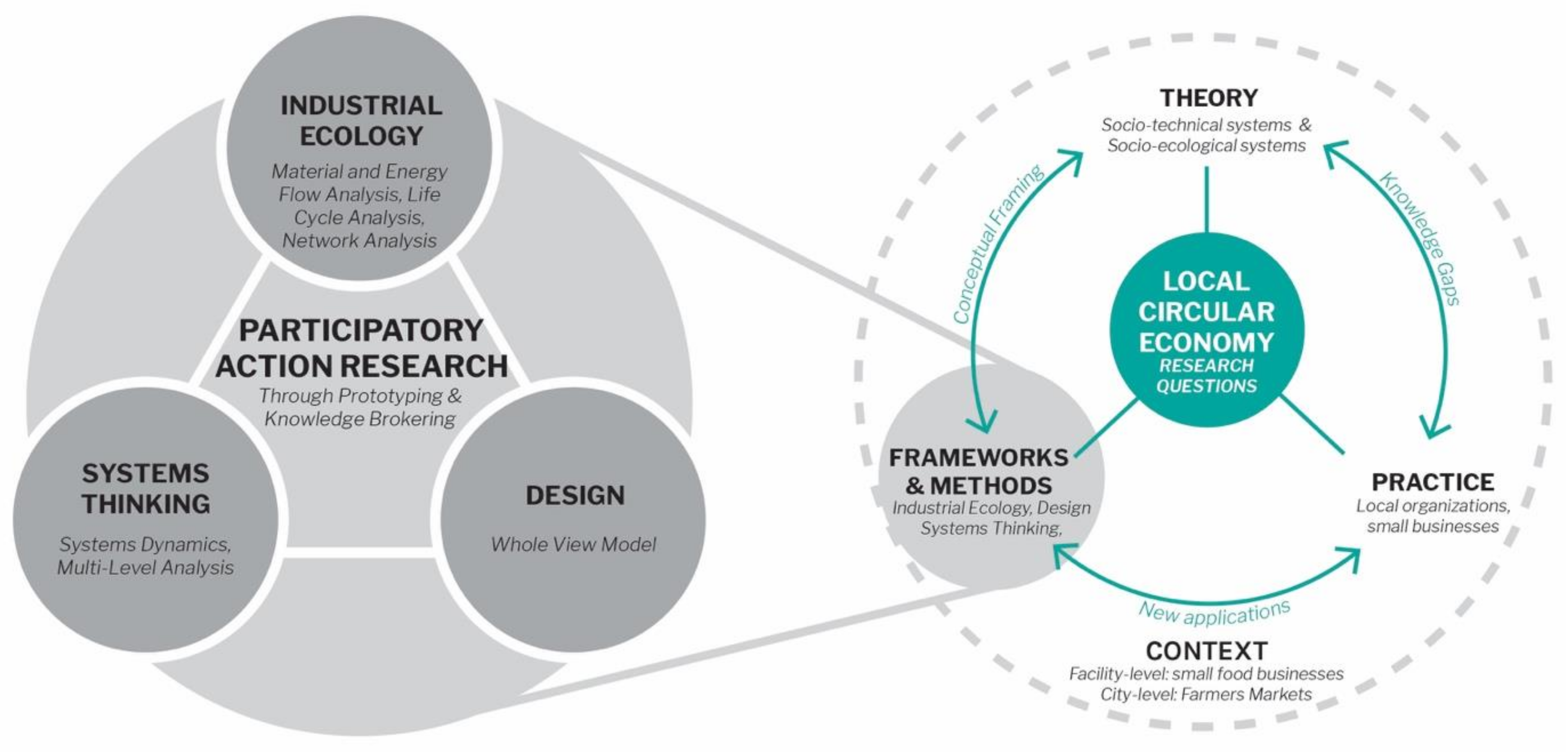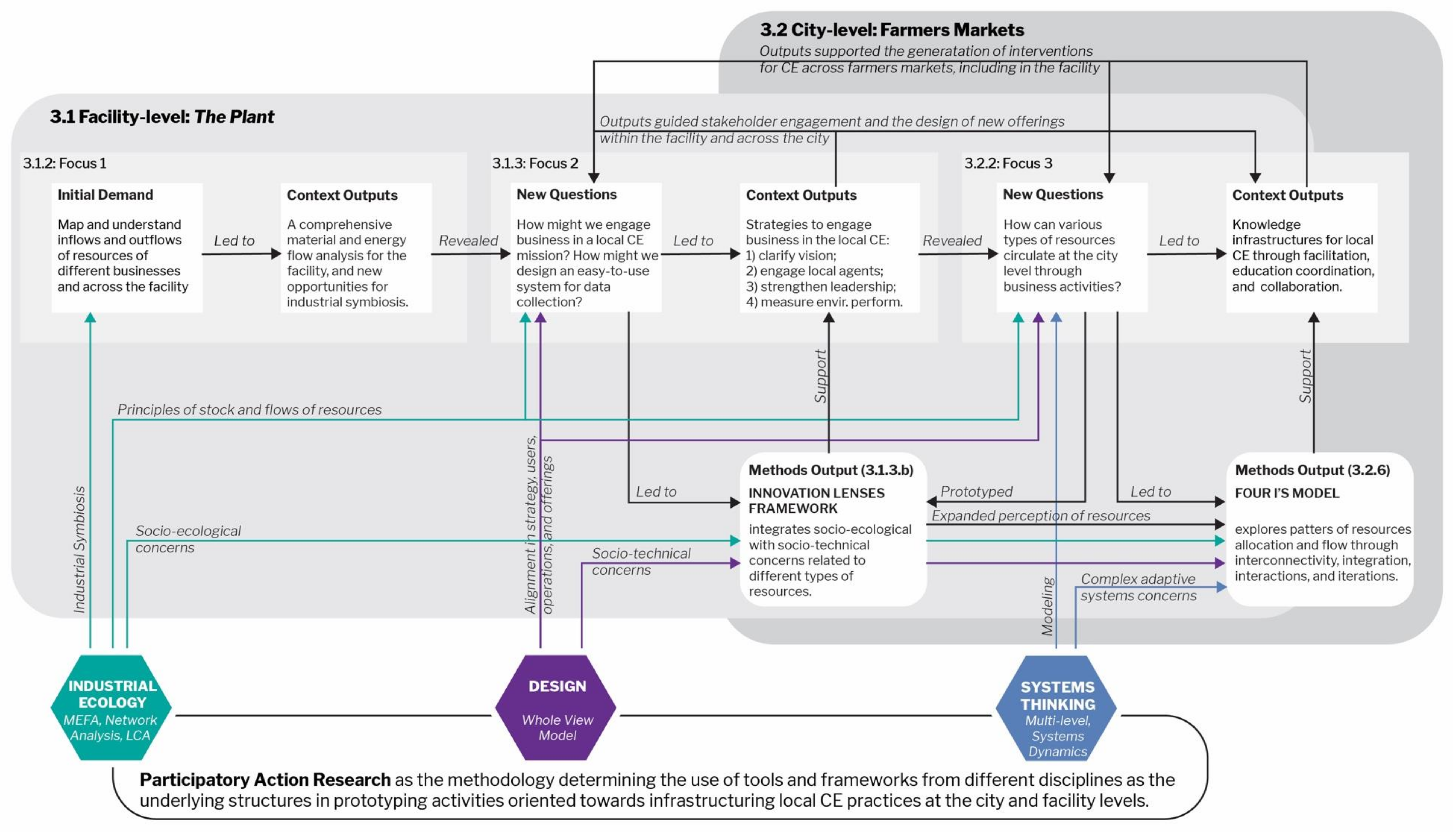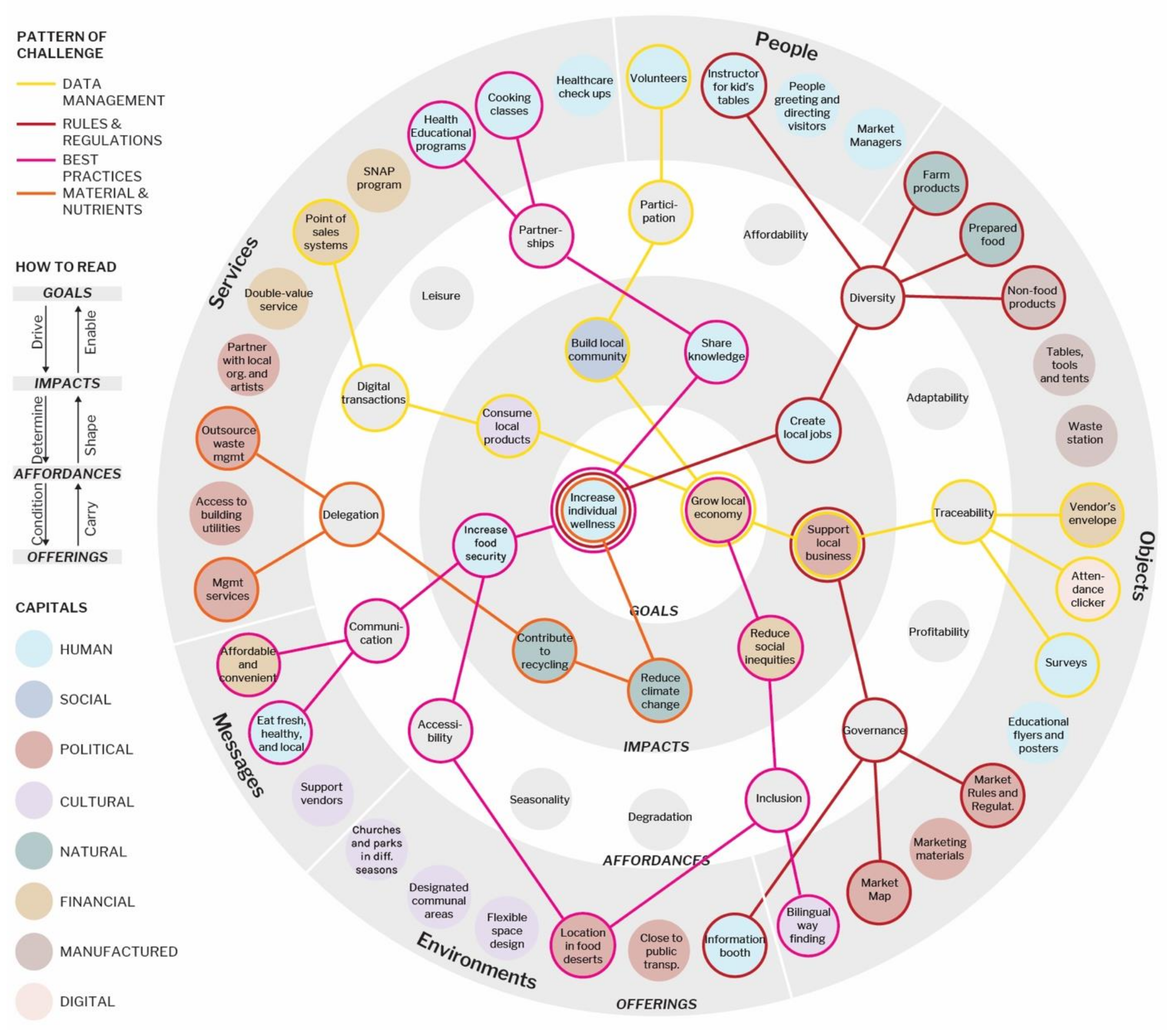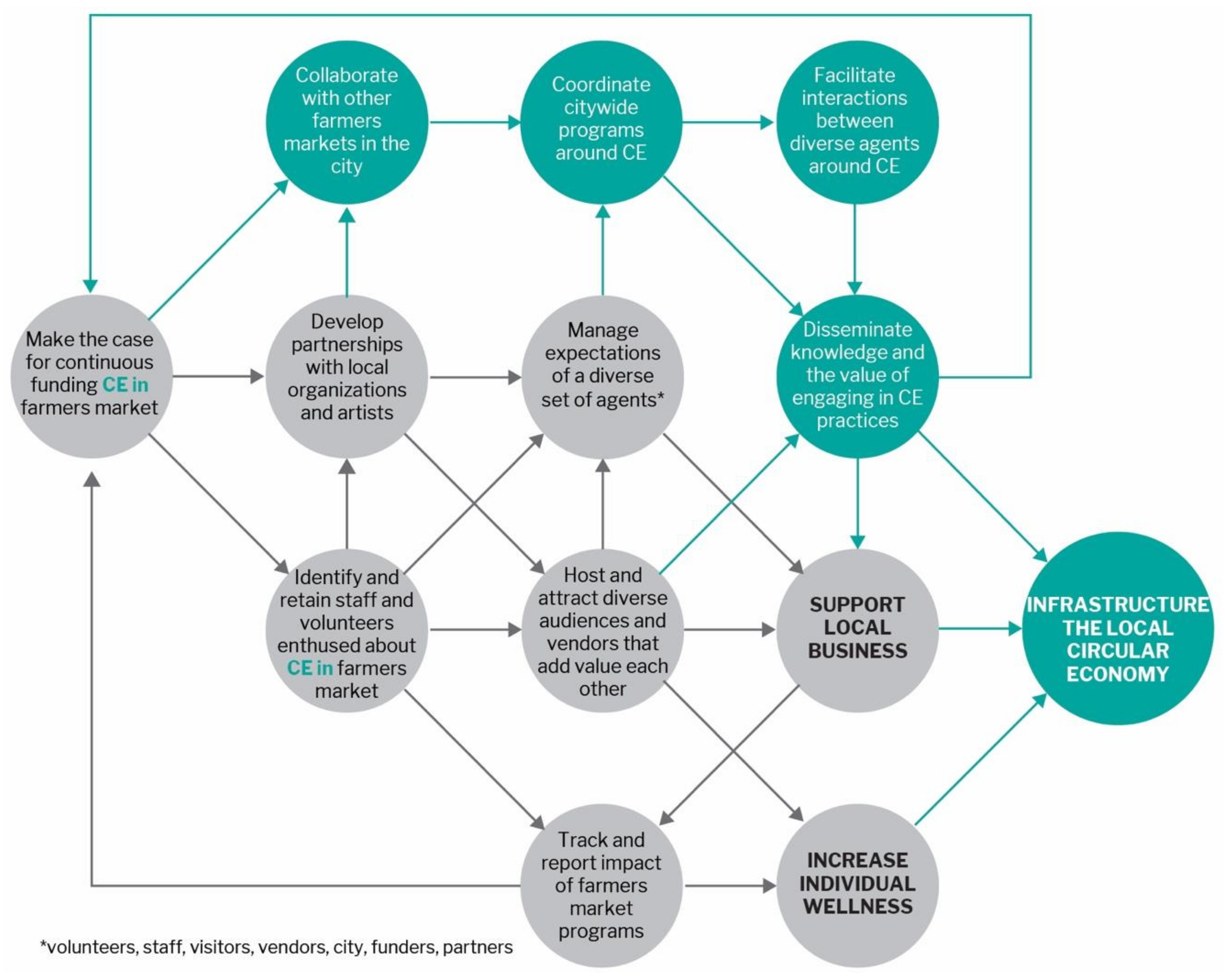Infrastructuring the Circular Economy
Abstract
1. Introduction
1.1. Urban Infrastructures
1.2. Urban Infrastructures and CE
1.3. Study Objectives
2. Materials and Methods
3. Results
3.1. Facility-Level: The Plant
3.1.1. Contextual Background and Problem Framing
3.1.2. Focus 1: Quantifying Material Flows, Industrial Symbiosis, and Circular Economy Potential at The Plant
3.1.3. Focus 2: Activating and Mobilizing Agents Advancing Circular Economy at The Plant
Expanding Perception of the Circular Economy at the Plant
Innovation Lenses Framework
3.2. City-level: Farmers Markets
3.2.1. Focus 3: Contextual Background and Problem Framing
3.2.2. Investigating Opportunities for Scaling Niche-Level CE Success to City-Level Impact
3.2.3. Application of the Innovation Lenses Framework in Farmers Markets in Chicago
3.2.4. Patterns of Challenges in Mobilizing Resources
- Digital and financial capital—managing diverse sets of data: Integrating data from multiple sources and transforming the results into meaningful information requires new competencies within current managerial practices. Farmers markets’ managers face the same challenges that managers in large organizations face: what data should be collected? Which sources should be integrated, and to what end? Yet, because farmers markets are usually run by small organizations with resource constraints, they had to develop the minimum necessary set of competencies to create the intended values for specific user groups. For this reason, they often do not have the capabilities to integrate environmental- or social-related data into their operations. This focus revealed an opportunity for collaboration around benchmarking and data sharing to communicate local circular economy practices with each other and with the City government.
- Political and cultural capital—updating rules and regulations: Market managers tend to align their practices and regulations with the larger goals of the City of Chicago programs. Markets must comply with a wide range of rules and regulations, but existing CE practices have emerged organically. Thus, where CE practices exist, they are defined by the vendor’s interest and are not explicitly encouraged by the City government. Through this work, the managers are exploring how they can shape new market regulations to encourage the adoption of local circular economy practices by vendors and customers.
- Human and social capital—sharing best practices: Several CE practices have taken root in markets across the city, but opportunities to accelerate and increase impact remain untapped. Chicago’s market managers currently share best practices with each other through informal relationships and infrequent gatherings. Without a formal infrastructure to create and sustain more open and inclusive mechanisms to share their learnings and experiences, many managers go through the same struggle at different times. Consequently, the overall farmers market operations become inefficient in resource allocation. This realization led managers to create a systematic way to learn from each other, employ proven successful practices at their markets, and advance the local circular economy.
- Natural and manufactured capital—managing materials and nutrients: Implementing a materials and nutrient management system based on CE practices can significantly increase the diversion of recyclable and biodegradable materials from landfills. In the past five years, a handful of markets have hired small, local food scrap haulers to handle their organic waste, but many markets identified lack of budget, infrastructure, knowledge, and available local services as barriers to diverting materials and nutrients from landfills. Since the majority of waste generated in farmers markets is biodegradable, the ability to implement a system that properly manages materials and nutrients is highly dependent on the market’s host site and the priorities of the market’s host organization. This insight led to the consideration of how managers could collaborate to create an affordable and effective system to divert materials and nutrients away from landfills.
3.2.5. CE Interventions
3.2.6. Four I’s Model
Interconnectivity of Organizational Levels
Integration of Multiple Systems
Interactions of Diverse Sets of Agents
Iterations over Time
4. Discussion
5. Conclusions
Author Contributions
Funding
Acknowledgments
Conflicts of Interest
References
- World Economic Forum; Ellen MacArthur Foundation; McKinsey & Company. Towards the Circular Economy: Accelerating the Scale-Up across Global Supply Chains; World Economic Forum: Geneva, Switzerland, 2014. [Google Scholar]
- Bocken, N.M.P.; De Pauw, I.; Bakker, C.; Van der Grinten, B. Product design and business model strategies for a circular economy. J. Ind. Prod. Eng. 2016, 33, 308–320. [Google Scholar] [CrossRef]
- Ellen MacArthur Foundation Circular Cities. Available online: https://www.ellenmacarthurfoundation.org/our-work/activities/circular-economy-in-cities (accessed on 12 February 2020).
- Agudelo-Vera, C.M.; Mels, A.R.; Keesman, K.J.; Rijnaarts, H.H.M. Resource management as a key factor for sustainable urban planning. J. Environ. Manag. 2011, 92, 2295–2303. [Google Scholar] [CrossRef] [PubMed]
- Markolf, S.A.; Chester, M.V.; Eisenberg, D.A.; Iwaniec, D.M.; Davidson, C.I.; Zimmerman, R.; Miller, T.R.; Ruddell, B.L.; Chang, H. Interdependent infrastructure as linked social, ecological, and technological systems (SETSs) to address lock-in and enhance resilience. Earths Future 2018, 6, 1638–1659. [Google Scholar] [CrossRef]
- Duranton, G.; Puga, D. Micro-foundations of urban agglomeration economies. In Handbook of Regional and Urban Economics; Working Paper 9931; National Bureau of Economic Research: Cambridge, MA, USA, 2003. [Google Scholar]
- Sennett, R. Building and Dwelling: Ethics for the City, 1st American ed.; Farrar, Straus and Giroux: New York, NY, USA, 2018; ISBN 978-0-374-20033-6. [Google Scholar]
- Carpenter, S.R.; DeFries, R.; Dietz, T.; Mooney, H.A.; Polasky, S.; Reid, W.V.; Scholes, R.J. Millennium ecosystem assessment: Research needs. Science 2006, 314, 257–258. [Google Scholar] [CrossRef]
- Millennium Ecosystem Assessment. Available online: https://www.millenniumassessment.org/en/Global.html (accessed on 12 February 2020).
- Moreau, V.; Sahakian, M.; Van Griethuysen, P.; Vuille, F. Coming full circle: Why social and institutional dimensions matter for the circular economy. J. Ind. Ecol. 2017, 21, 497–506. [Google Scholar] [CrossRef]
- Block, D.; Rosing, H. Chicago: A Food Biography; Rowman & Littlefield: Lanham, MD, USA, 2015; ISBN 978-1-4422-2726-2. [Google Scholar]
- Block, D.R.; Chavez, N.; Allen, E.; Ramirez, D. Food sovereignty, urban food access, and food activism: Contemplating the connections through examples from Chicago. Agric. Hum. Values 2011, 29, 203–215. [Google Scholar] [CrossRef]
- Caron, P.; Ferrero y de Loma-Osorio, G.; Nabarro, D.; Hainzelin, E.; Guillou, M.; Andersen, I.; Arnold, T.; Astralaga, M.; Beukeboom, M.; Bickersteth, S.; et al. Food systems for sustainable development: Proposals for a profound four-part transformation. Agron. Sustain. Dev. 2018, 38, 41. [Google Scholar] [CrossRef]
- Zumkehr, A.; Campbell, J.E. The potential for local croplands to meet US food demand. Front. Ecol. Environ. 2015, 13, 244–248. [Google Scholar] [CrossRef]
- Heller, M.C.; Keoleian, G.A. Greenhouse gas emission estimates of U.S. dietary choices and food loss. J. Ind. Ecol. 2015, 19, 391–401. [Google Scholar] [CrossRef]
- Bozeman, J.F.; Ashton, W.S.; Theis, T.L. Distinguishing environmental impacts of household food-spending patterns among U.S. demographic groups. Environ. Eng. Sci. 2019, 36, 763–777. [Google Scholar] [CrossRef]
- Clark, M.A.; Springmann, M.; Hill, J.; Tilman, D. Multiple health and environmental impacts of foods. Proc. Natl. Acad. Sci. USA 2019, 116, 23357–23362. [Google Scholar] [CrossRef] [PubMed]
- Ostrom, E. A General framework for analyzing sustainability of social-ecological systems. Science 2009, 325, 419–422. [Google Scholar] [CrossRef]
- Malecki, E.J. Hard and soft networks for urban competitiveness. Urban Stud. 2002, 39, 929–945. [Google Scholar] [CrossRef]
- Sovacool, B. Hard and soft paths for climate change adaptation. Clim. Policy 2011, 11, 1177–1183. [Google Scholar] [CrossRef]
- Larkin, B. The politics and poetics of infrastructure. Annu. Rev. Anthropol. 2013, 42, 327–343. [Google Scholar] [CrossRef]
- Edwards, P.N. Infrastructure and modernity: Force, time, and social organization in the history of sociotechnical systems. Mod. Technol. 2003, 1, 185–226. [Google Scholar]
- Star, S.L. The sociology of the invisible: The primacy of work in the writings of Anselm Strauss. In Social Organization and Social Process: Essays in Honor of Anselm Strauss; Transaction Publishers: Piscataway, NJ, USA, 1991; pp. 265–283. [Google Scholar]
- Jewett, T.; Kling, R. The dynamics of computerization in a social science research team: A case study of infrastructure, strategies, and skills. Soc. Sci. Comput. Rev. 1991, 9, 246–275. [Google Scholar] [CrossRef]
- Latour, B.; Hermant, E.; Shannon, S. Paris: Invisible City; Institut Synthélabo pour le progrès de la connaissance: Paris, France, 1998. [Google Scholar]
- Star, S.L. The ethnography of infrastructure. Am. Behav. Sci. 1999, 43, 377–391. [Google Scholar] [CrossRef]
- Star, S.L.; Ruhleder, K. Steps toward an Ecology of Infrastructure: Design and Access for Large Information Spaces. Inf. Syst. Res. 1996, 7, 111–134. [Google Scholar] [CrossRef]
- Bonato, D.; Orsini, R. Urban circular economy: The new frontier for european cities’ sustainable development. In Sustainable Cities and Communities Design Handbook; Butterworth-Heinemann: Oxford, UK, 2018; pp. 235–245. [Google Scholar]
- Petit-Boix, A.; Leipold, S. Circular economy in cities: Reviewing how environmental research aligns with local practices. J. Clean. Prod. 2018, 195, 1270–1281. [Google Scholar] [CrossRef]
- La Recyclerie. Available online: http://www.larecyclerie.com/ (accessed on 12 February 2020).
- Recycle Here! Detroit. Available online: http://www.recyclehere.net/ (accessed on 13 February 2020).
- Amsterdam Policy: Circular Economy. Available online: https://www.amsterdam.nl/en/policy/sustainability/circular-economy/ (accessed on 12 February 2020).
- Circular Charlotte. Envision Charlotte; Circular Charlotte: Charlotte, NC, USA, 2018. [Google Scholar]
- Wang, N.; Lee, J.C.K.; Zhang, J.; Chen, H.; Li, H. Evaluation of Urban circular economy development: An empirical research of 40 cities in China. J. Clean. Prod. 2018, 180, 876–887. [Google Scholar] [CrossRef]
- Ezzat, A.M. Sustainable development of seaport cities through circular economy: A comparative study with implications to Suez Canal corridor project. Eur. J. Sustain. Dev. 2016, 5, 509. [Google Scholar] [CrossRef]
- Ozanne, J.L.; Saatcioglu, B. Participatory Action Research. J. Consum. Res. 2008, 35, 423–439. [Google Scholar] [CrossRef]
- Klerkx, L.W.A.; Van Mierlo, B.; Leeuwis, C. Evolution of systems approaches to agricultural innovation: Concepts, analysis and interventions. In Farming Systems Research into the 21st Century: The New Dynamic; Springer: Dordrecht, The Netherlands, 2012; pp. 457–483. ISBN 978-94-007-4502-5. [Google Scholar]
- Forlano, L. Decentering the Human in the Design of Collaborative Cities. Des. Issues 2016, 32, 42–54. [Google Scholar] [CrossRef]
- Ehn, P. Participation in design things. In Proceedings of the Participatory Design Conference 2008, Bloomington, IN, USA, 30 September–4 October 2008; ACM: New York, NY, USA. [Google Scholar]
- Baum, F.; MacDougall, C.; Smith, D. Participatory action research. J. Epidemiol. Community Health 2006, 60, 854–857. [Google Scholar] [CrossRef]
- Chevalier, J.M.; Buckles, D. Participatory Action Research: Theory and Methods for Engaged Inquiry; Routledge: Abingdon, UK, 2013; ISBN 978-0-415-54031-5. [Google Scholar]
- Teram, E.; Schachter, C.L.; Stalker, C.A. The case for integrating grounded theory and participatory action research: Empowering clients to inform professional practice. Qual. Health Res. 2005, 15, 1129–1140. [Google Scholar] [CrossRef] [PubMed]
- Nogueira, A.; Teixeira, C.; Ashton, W.S. Innovation Lenses Playbook; Illinois Institute of Technology: Chicago, IL, USA, 2018. [Google Scholar]
- Ashton, W.; Lifset, R. Industrial Ecology. In Encyclopedia of Sustainability, Vol. 4: Natural Resources and Sustainability; Vasey, D., Christensen, K., Shen, L., Thompson, S., Eds.; Berkshire: Great Barrington, MA, USA, 2012. [Google Scholar]
- Ashton, W. Understanding the Organization of Industrial Ecosystems: A Social Network Approach. J. Ind. Ecol. 2008, 12, 34–51. [Google Scholar] [CrossRef]
- Meadows, D. Thinking in Systems; Chelsea Green Publishing: Windsor, VT, USA, 2008. [Google Scholar]
- Whitney, P. Design and the Economy of Choice. She Ji J. Des. Econ. Innov. 2015, 1, 58–80. [Google Scholar] [CrossRef][Green Version]
- Bertola, P.; Teixeira, J.C. Design as a knowledge agent: How design as a knowledge process is embedded into organizations to foster innovation. Des. Stud. 2003, 24, 181–194. [Google Scholar] [CrossRef]
- Bubbly Dynamics LLC. Available online: https://www.bubblydynamics.com (accessed on 13 February 2020).
- Mulrow, J.S.; Derrible, S.; Ashton, W.S.; Chopra, S.S. Industrial Symbiosis at the Facility Scale. J. Ind. Ecol. 2017, 21, 559–571. [Google Scholar] [CrossRef]
- Plant Chicago. Available online: https://plantchicago.org/ (accessed on 13 February 2020).
- Chance, E.; Ashton, W.; Pereira, J.; Mulrow, J.S.; Norberto, J.; Derrible, S.; Guilbert, S. The Plant—An experiment in urban food sustainability. Environ. Prog. Sustain. Energy 2018, 37, 82–90. [Google Scholar] [CrossRef]
- Ashton, W.; Nogueira, A.; Lad, R.; Lerczak, J.; McKitterick, M.; Urteaga, F.; Wen, T. Implementing the Circular Economy at The Plant; Illinois Institute of Technology & Plant Chicago: Chicago, IL, USA, 2017. [Google Scholar]
- Nogueira, A.; Ashton, W.S.; Teixeira, C. Expanding perceptions of the circular economy through design: Eight capitals as innovation lenses. Resour. Conserv. Recycl. 2019, 149, 566–576. [Google Scholar] [CrossRef]
- Flora, C.; Flora, J.; Fey, S. Rural Communities: Legacy and Change, 2nd ed.; Westview Press: Boulder, CO, USA, 2004. [Google Scholar]
- Siegner, A.; Sowerwine, J.; Acey, C. Does urban agriculture improve food security? Examining the nexus of food access and distribution of urban produced foods in the United States: A systematic review. Sustainability 2018, 10, 2988. [Google Scholar] [CrossRef]
- Morales, A.; Kettles, G. Healthy food outside: Farmers’ markets, taco trucks, and sidewalk fruit vendors. J. Contemp. Health Law Policy 2009, 26, 20. [Google Scholar]
- Kumar, V. 101 Design Methods: A Structured Approach for Driving Innovation in Your Organization; John Wiley & Sons: Hoboken, NJ, USA, 2012. [Google Scholar]
- George, D.R.; Kraschnewski, J.L.; Rovniak, L.S. Public health potential of farmers’ markets on medical center campuses: A case study from Penn State Milton S. Hershey Medical Center. Am. J. Public Health 2011, 101, 2226–2232. [Google Scholar] [CrossRef] [PubMed]
- Nogueira, A.; Lyon, E. The Future of Farmers Market; Plant Chicago: Chicago, IL, USA, 2018. [Google Scholar]
- Jones, P.; Bhatia, R. Supporting equitable food systems through food assistance at farmers’ markets. Am. J. Public Health 2011, 101, 781–783. [Google Scholar] [CrossRef] [PubMed]
- Nogueira, A. Sustainable Solutions in Complex Spaces of Innovation. Ph.D. Thesis, Illinois Institute of Technology, Chicago, IL, USA, 2019. [Google Scholar]
- Heskett, J. Design from the Standpoint of Economics/Economics from the Standpoint of Design. In A John Heskett Reader: Design, History, Economics; Bloomsbury: London, UK, 2016. [Google Scholar]
- Holland, J.H. Signals and Boundaries: Building Blocks for Complex Adaptive Systems; MIT Press: Cambridge, MA, USA, 2012. [Google Scholar]
- Cass, N.; Schwanen, T.; Shove, E. Infrastructures, intersections and societal transformations. Technol. Forecast. Soc. Change 2018, 137, 160–167. [Google Scholar] [CrossRef]
- Boonstra, W. Conceptualizing power to study social-ecological interactions. Ecol. Soc. 2016, 21, 21. [Google Scholar] [CrossRef]
- Geels, F. Regime resistance against low-carbon transitions: Introducing politics and power into the multi-level perspective. Theory Cult. Soc. 2014, 31, 21–40. [Google Scholar] [CrossRef]
- Edwards, P.N.; Jackson, S.J.; Chalmers, M.K.; Bowker, G.C.; Borgman, C.L.; Ribes, D.; Burton, M.; Calvert, S. Knowledge Infrastructures: Intellectual Frameworks and Research Challenges; University of Michigan: Ann Arbor, MI, USA, 2013. [Google Scholar]




| Social | |||
|---|---|---|---|
| Human | Social | Cultural | Political |
| The ability and capability of individuals to produce and manage their well-being. It includes individual health, knowledge, skills, and motivation. | The professional and social connections among agents. It includes partnerships and collaborations, as well as informal gatherings. | Values and beliefs inherent in social practices, or incorporated by communities, that determine patterns of behavior being encouraged, discouraged, or tolerated by individuals and organizations over time. It also includes ethnicity, spirituality, heritage, traditions, and daily practices. | Governing structures in organizations that determine how decisions are made and power is distributed. It involves hierarchy, inclusion, equity, transparency, access, and participation. |
| Ecological | Technical | ||
| Natural | Financial | Manufactured | Digital |
| Comprises natural resources, both renewable and nonrenewable. It also includes fauna and flora, as well as their life-supporting systems. | The productive power in the resources of other types of capitals. It includes the resources and assets of an individual or entity translated in the form of a currency that can be accessed, owned, or traded. | All material goods. It includes human-made elements such as physical infrastructures, roads, artifacts, and machines. | Digital infrastructure and data. It includes digital platforms, as well as the mechanisms of data collection, analysis, and storage. |
| Capital | Dimension | Stocks | Flows | ||
|---|---|---|---|---|---|
| Guiding Question | Examples | Guiding Question | Examples | ||
| Human | Knowledge | Whose knowledge and labor are considered? | Market managers knowledge of regulations, advertising, and vendors knowledge of produce and goods | How and where is knowledge being created, and for whom? | Market managers analyze data and activities of markets and act accordingly |
| Well-being | How is the capacity of individuals to perform defined? | Individuals’ health, education | What activities maintain or enhance individuals’ capacity to perform? | Cooking classes, healthcare check ups | |
| Social | Professional | Who is considered a partner in farmers markets? What is the nature of the partnership or affiliation? | Suppliers, market vendors, city officials, volunteers | How and where are partnerships being formed? | Outreach of market managers, vendor applications, networking events across the city, vendor training |
| Personal | What informal ties exist within current operations? | Relations among managers, vendors, and customers help them to participate in the market | How and where are activities supporting informal gatherings happening? | Informal social gatherings in designated common areas among managers, vendors, and customers | |
| Cultural | Local | What are the local traditions and cultural heritage farmers markets rely upon, and what values and beliefs they sustain? | Local food producers, activists of local and organic movements, language and vocabulary used to communicate with visitors | How and where are the cultural practices and values manifested? | Selection of farmers/vendors/activities presented at market |
| Global | What global elements and practices have been incorporated? | Organic certification/standards, variety of attractions beyond food (e.g., health, music, art, dance), bilingual communications | How and where are new global practices being incorporated? | Market managers host diverse activities, media messaging about food safety and health, local grocery stores pose competition | |
| Political | Regulations | What are the local, state, and federal policies influencing decisions in farmers markets? | City regulations, state/federal food safety rules, funding available for different types of markets, food assistance programs | How and where are policies being enforced or changed? | Market managers have to follow food safety compliance, vendors, and double-value data collection, waste management |
| Norms | What is the power structure within current operations? | Market owners/managers make decisions for all participants, vendors, and consumers | How and where are decisions being made, or power shifts taking place? | Decisions are typically made by owners/managers, outside of the market, and presented to vendors prior to the event | |
| Natural | Fauna and Flora | What is the composition of flora and fauna species supporting the farmers markets? | Vegetables and animal products sold, organic and conventionally produced within and outside the city | How are species growth rates affected by the market activities? | Farming practices, organic and conventional, tend to disrupt the ecosystems in which they exist |
| Life support systems | What are the energy, materials, and services provided by nature to farmers markets? | Soil for growing produce to be consumed by people or other animals | How and where are energy and nutrients being extracted and regenerated? | Extraction of resources happen within and outside the city, most markets outsource their waste management services | |
| Financial | Services | What institutions provide financial services to agents participating in the markets? | Loans: banks, credit unions; Grants: federal, state, and local governments, foundations; Payments: consumer income, government food assistance | How and where are financial services being provided? | Formal financing of vendor operations; on-site ATMs, SNAP program, double-value services |
| Money | What is the institutional structure defining value? | Financial institutions, philanthropic foundations, market competition | How and where are monetary flows occurring? | Outside market: grants, expenses; Inside market: product sale transactions | |
| Manufactured | Infrastructure | What is the physical infrastructure available and its condition? | Transportation networks, automobiles, market-owned space furniture, building and city utilities | How and where is physical infrastructure being used and enhanced? | Location of the market determines accessibility and space occupation; seasonal markets may occupy different spaces |
| Products and Services | What products, byproducts, and services support activities? | Packaging, marketing materials, educational activities, kids table | How and where are products and services being produced and consumed? | Packaging typically produced elsewhere and discarded at consumers’ homes. | |
| Digital | Infrastructure | What are the digital infrastructures available? | Points of sale systems, social media, computers | How and where are digital infrastructure and data used and enhanced? | Data analyzed to gain additional funding |
| Data and Information | What data and information supports activities? | Quantified attendance, sales data | How and where are data collected and managed? | Managers and vendors collect data on sales, attendance, promotions | |
© 2020 by the authors. Licensee MDPI, Basel, Switzerland. This article is an open access article distributed under the terms and conditions of the Creative Commons Attribution (CC BY) license (http://creativecommons.org/licenses/by/4.0/).
Share and Cite
Nogueira, A.; Ashton, W.; Teixeira, C.; Lyon, E.; Pereira, J. Infrastructuring the Circular Economy. Energies 2020, 13, 1805. https://doi.org/10.3390/en13071805
Nogueira A, Ashton W, Teixeira C, Lyon E, Pereira J. Infrastructuring the Circular Economy. Energies. 2020; 13(7):1805. https://doi.org/10.3390/en13071805
Chicago/Turabian StyleNogueira, André, Weslynne Ashton, Carlos Teixeira, Elizabeth Lyon, and Jonathan Pereira. 2020. "Infrastructuring the Circular Economy" Energies 13, no. 7: 1805. https://doi.org/10.3390/en13071805
APA StyleNogueira, A., Ashton, W., Teixeira, C., Lyon, E., & Pereira, J. (2020). Infrastructuring the Circular Economy. Energies, 13(7), 1805. https://doi.org/10.3390/en13071805






